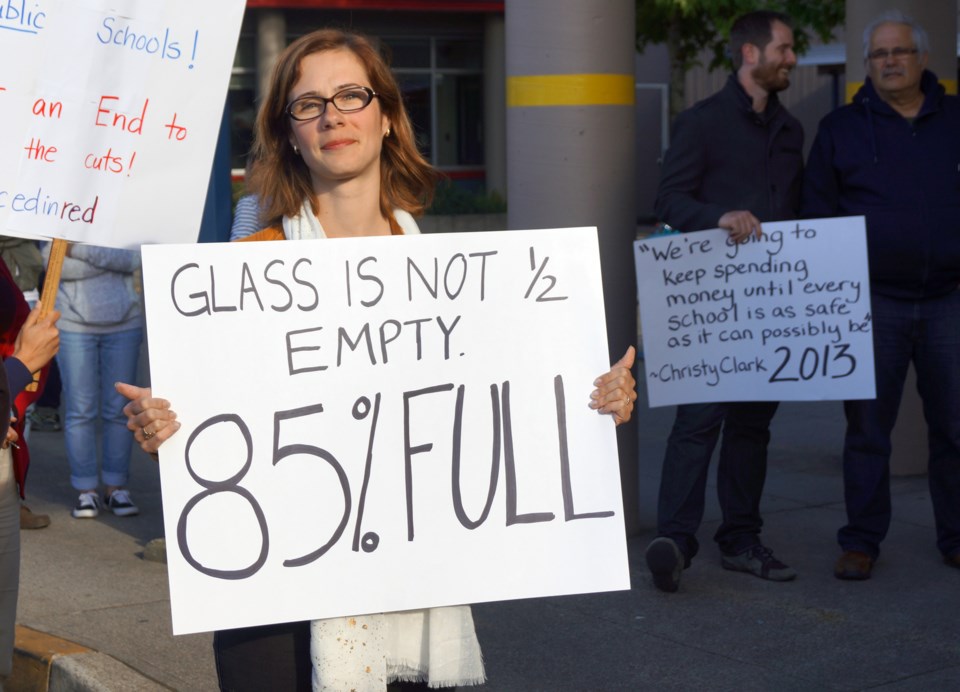Dear Editor,
Re: “Tablotney practical, Day opportunistic,” Letters, June 22.
I am sure Mr. and Mrs. Tablotney worked hard to fight the closure of their children’s school in 1990. However, today I find the level of Mrs. Tablotney’s efforts to champion the schools of Richmond to be underwhelming. How often has the school board, of which Mrs. Tablotney is chair, pushed back against the provincial government’s dictate that seismic upgrade funding be dependent on schools operating at 95 per cent capacity? How vocal and vigorously has Mrs. Tablotney championed the cause of Richmond’s schools and their children?
Mr. Tablotney decries the school board in 1990, running “roughshod over anyone who dared to oppose” them. Granted, today the Richmond school board is holding public meetings, and I am certain a lot of effort has been expended during this year-long process, but there are critical flaws in this consultation, one of them being how capacity is calculated.
Half of the schools on the possible closure list are at 75 per cent capacity or better. But the board has decided that French immersion and Montessori programs are fully portable anywhere in the city. Also, the provincial government does not include rooms, such as music or art studios, multi–purpose rooms, or childcare spaces, in the calculation. A small allowance is given for non–classroom space per child, but it does not allow educators to have the resources to deploy a quality education.
Mr. Tablotney, perhaps you can tell us if Mrs. Tablotney has petitioned the provincial government to either calculate capacity differently, or to lower the capacity to 85 per cent from 95 per cent?
As one of the organizers of the rally, I can assure the public that every Richmond trustee was invited to attend on June 18. As of the morning of June 17, none had replied. Three trustees did show up — Sandra Nixon, Ken Hamaguchi, and Eric Yung — and had any of them contacted us in advance, we would have gladly invited them to speak.
Mike Lombardi, Vancouver School Board (VSB) chair, was kind enough to speak in solidarity with the difficulties we, Richmond and Vancouver, face with the BC Liberal government. His school board is facing very much the same issues with capacity and seismic upgrading. However, the VSB has courageously defended the right of their children to have a safe and quality education, at the risk of their own jobs. To suggest that having Mr. Lombardi speak was an “unbelievably irresponsible decision” is amusing. An unbelievably irresponsible decision is to withhold seismic upgrade funding, thus forcing schoolchildren to attend schools that will likely suffer structural failure in the event of an earthquake.
Mr. Tablotney also calls out the VSB for running schools at 30 percent capacity. Richmond has two schools that are not (even) running at 30 per cent capacity. Also, the Richmond board has covered the deficit from provincial cutbacks by using a $2 million surplus from a previous year. How is that a “responsible business” decision, and how is that sustainable? In addition, $335,000 was cut from Richmond’s school supplies and $200,000 from HVAC services. I can tell you that PACs will need to fundraise for the missing school supplies, and air quality will suffer.
This is an unsustainable practice, and the people of Richmond need someone with the courage to say no.
As for Mr. Tablotney’s dissatisfaction with Carol Day and “her two cents,” I have a question. How are you, Mr. Tablotney, part of the solution? Ms. Day is thinking of alternatives for RSB assets, so they can be used for the benefit of Richmond’s communities.
Richmond is waiting for a champion for their communities, which are fundamentally supported by the vibrancy that young families provide. Remove a school, and you remove the future of that neighbourhood. Will the Richmond trustees step up and demand better for the future of its smallest citizens?
Kelly Greene
Richmond



